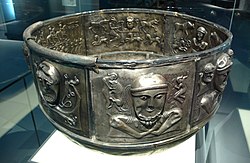Germanic paganism
Germanic paganism was a religion that was a form of paganism. It was practiced in Central and Northern Europe before Christianity came there. The best-known form is now called Norse mythology. Being polytheistic, the religion haf many gods. The main ones seem to have been Odin, Thor and Tyr, which may have been the most important one.
Modern influence
| Day | Origin |
|---|---|
| Monday | Moon's day |
| Tuesday | Tiw's (Tyr's) day |
| Wednesday | Wóden 's (Odin's) day |
| Thursday | Þunor's (Thor's) day |
| Friday | Frigg's day |
| Sunday | Sun's day |
The Germanic gods have affected elements of everyday western life in most countries that speak Germanic languages. An example is some of the names of the days of the week, which come from Germanic deities. In English and Dutch, Saturn was not replaced. Saturday is named after the Sabbath in German and is called "washing day" in Scandinavia.
Also, many place names in England such as Woodway House, Wansdyke, Thundersley and Frigedene are named after the old deities of the English people.
More recently, people have created a modern form of Germanic paganism, called Asatru.
Germanic Paganism Media
A 5th or 6th-century C-type bracteate (DR BR42) showing a figure, likely Odin, above a horse with dislocated legs. This may refer to Odin's healing of Baldr's horse in the Second Merseburg Charm and was likely a talisman.[1]
The B inscription on the Negau helmet, c. 450-350 BCE. This inscription may be the earliest attestation of the name of the Germanic god Tyr's name.[2]
The Gundestrup Cauldron. Found in a bog in Denmark, the cauldron was likely made by Celts in Romania or Bulgaria. Decorated with motifs from Celtic mythology, it is evidence of Celtic-Germanic contact.[5]
The pages of manuscript Clm 22053 containing the 9th-century Old High German Wessobrunn Prayer, which seems to describe the time before creation similarly to the Old Norse pagan sources.[6]
Ismantorp Fortress, an Iron Age ringfort from c. 300-600 CE on Öland island, Sweden. Anders Andrén has argued that the structure is meant to represent Midgard, the enclosed, inhabited world.[7]
Opening illustration of the Origo gentis Langobardorum, showing the Gods Godan (Odin) and Frea (Frigg) at the upper left corner.
- ↑ Simek 1993, p. 278.
- ↑ Schjødt 2020b, p. 250.
- ↑ Lindow 2020d, p. 1095.
- ↑ Schjødt 2020b, p. 257.
- ↑ Egeler 2020, p. 291.
- ↑ Hultgård 2010c, p. 485, 488-489.
- ↑ Nordvig 2020b, p. 1012-1013.
- ↑ Lindow & Andrén 2020, pp. 907-908.
- ↑ Lindow & Andrén 2020, p. 915.








